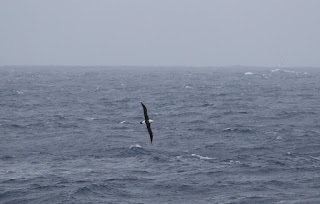The Southern Ocean cruise on the Coral Princess that I was present for from 25 Jan-6 Feb 2020 covered a lot of territory from The Falkland Islands to San Antonio, Chile. Being an albatross virgin before the cruise I was happy to come with 8 species of albatrosses during the trip. The first species was Black-browed Albatross. This as expected was the most numerous and universally present albatross of the cruise. This was a good albatross to get to know because it is the most likely species to occur in Atlantic Canada waters. This is the only species confirmed for the province of Newfoundland and Labrador with three photographic records. Being a relatively tame bird that was not shy of the huge cruise ship it often came close providing many photo opportunities. Nearly all were adults. I noticed far fewer than 1% being dark billed immatures. That is fine since at least two of the Newfoundland and Labrador records were bright billed adults.
Almost patterned like an adult Great Black-backed Gull, the black tail with a bright white rump about equal to the size of the bright white head distinguishes it from any gull, if the size and shape was not immediately obvious. The same clean cut colour pattern also distinguishes it from a sub-adult Northern Gannet.
Even a distant Black-browed Albatross should stand out by size and sharp black and white pattern in Newfoundland waters.
The Black-browed Albatross dwarfs our shearwaters, fulmars and gulls when close enough to compare directly. Here and in the following three pictures it is with Sooty Shearwater.
Up close the adult Black-browed Albatross is a smartly feathered bird.
---------------------------------------------------
Immatures are distinguished from adults by the dark gray bill, the dirty gray wash on the back of the neck and a wider black border to the underwings (see also next two pictures).
Immature
Immature
Adult
Adult
The Black-browed Albatross is an abundant species.



















No comments:
Post a Comment
Note: only a member of this blog may post a comment.